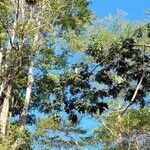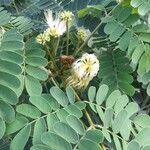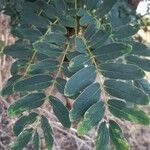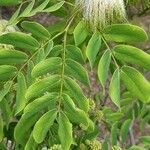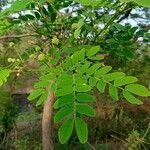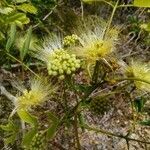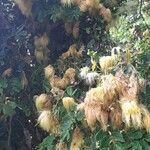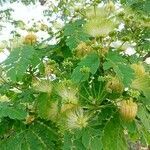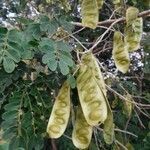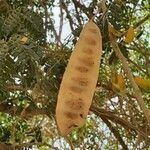Small or moderate, spreading tree, the branchlets puberulent when young soon becoming glabrous, conspicuously white-lenticellate. Leaves moderately large, mostly bipinnate, the pinnae 2-4 pairs opposite on the rachis, the leaflets 4-9 pairs; petiole 2-10 cm. long, glabrous, bearing on the upper side below the middle a sessile, oblong, concave gland; primary rachis similar, to the petiole, sulcate above, often bearing a sessile, scutelliform gland at insertion of the upper pair of pinnae; pinnular rachis similar, bearing at or just below the upper 2-3 rachial nodes glands like the gland of the petiole; leaflets opposite, asymmetrically oblong, 2-4 cm. long and mostly 1-2 cm. wide, rounded-subtruncate to obtuse apically, obtuse and very inequilateral basally, essentially glabrous above and below. Inflorescence of many long-pedunculate umbels axillary from the subterminal nodes (2-3 per node); peduncles 3-10 cm. long, sparingly puberulent; umbels dense, globose, the pedicels mostly about 2 mm. long, the bractlets minute. Flowers cream-colored, fragrant; calyx funnelform, about 4 mm. long, unequally toothed or cleft, golden-tomentulose apically; corolla funnelform, 6-7 mm. long, puberulent, the teeth prominent; stamens many, as much as 3 cm. long, glabrous, the staminal tube well included; ovary glabrous. Legume broadly linear or narrowly oblong, usually 15 or more cm. long and 3-5 cm. wide, very thin and dry, glabrous, thinly mar-gined, transversely striate; seeds few, transverse.
Tree to 15 m high with a rounded crown. Bark grey to light brown, rough; young branchlets glabrous or pubescent. Leaves subglabrous, puberulous or pubescent: petiole 4-8 cm long, usually with a raised gland a short distance above the pulvinus; rhachis (0)1.3-8(20) cm long, usually with a gland just below the junction of the top pinna pair; pinnae (1)2-4(5) pairs; rhachillae 4-11(16) cm long, often with a small gland below the junction of each leaflet pair; leaflets 3-9(11) pairs, 15-45 x (6)8-24 mm, obliquely oblong or elliptic-oblong (terminal leaflets ± obovate), somewhat asymmetric with the midrib nearer the upper margin, rounded or somewhat emarginate apically, glabrous or rarely thinly pubescent above, glabrous to pubescent beneath. Inflorescences globose; peduncles 4-8 cm long, sparingly puberulous to pubescent. Flowers whitish, on pedicels 1.5-4.5 mm long; bracteoles 2-3 mm long, rapidly deciduous. Calyx (2.5)3.5-5 mm long, grey-to fulvous-pubescent. Corolla 5.5-9 mm long, glabrous except for puberulence towards the apices of the lobes. Stamens 1.5-2.5 cm long, united basally for ±5 mm, tube not or scarcely exserted beyond the corolla. Ovary ±2 mm long, glabrous. Pods straw-coloured to light brown, (9)12-25(33) x 3-4.5 cm, oblong, valves coriaceous, glabrous or almost so, glossy, ± venose, conspicuously umbonate over the seeds, margins thickened, very tardily dehiscent and often only after falling to the ground. Seeds 7-11.5 x 7-9 mm, flattened.
Trees, deciduous, 8-12 m tall. Bark rough. Branchlets minutely pubescent, glabrous when old. Stipules caducous, small; leaf rachis with disklike glands near base and at base of pinnae, pubescent or glabrous; pinnae 2-4 pairs, 6-15 cm; leaflets 4-8 pairs, narrowly elliptic or slightly obliquely oblong, 2-4.5 × (0.9-)1.3-2 cm, both surfaces glabrous or abaxially sparsely finely pubescent, main vein slightly closer to upper margin, apex obtuse or retuse. Peduncles axillary, 2 or more together, to 10 cm; corymbs 30-40-flowered. Flowers dimorphic, fragrant; pedicels 3-4 mm, puberulent. Calyx funnel-shaped, ca. 4 mm, puberulent, with short teeth. Corolla green-yellow, funnel-shaped, 7-8 mm; lobes deltoid-ovate. Stamens white or light yellow-green; tube shorter than corolla tube. Ovary glabrous, sessile. Legume straw-colored, strap-shaped, flat, 15-28 × 2.5-4.5 cm, remaining on trees long after ripening. Seeds brown, 4-12, ellipsoidal, ca. 10 × 6-7 mm; pleurogram parallel to margins of seed. Fl. May-Sep, fr. Oct-May of following year. 2n = 26*.
Tree 2.5-30 m tall; bark rough, grey and corky. Leaves: axes with gland on petiole and smaller ones between upper pairs of leaflets, glabrous or puberulous; pinnae 2-4-jugate. Leaflets 3-7 (-13)-jugate, subsessile, inequilaterally oval or oblong, 1.5-4.5 cm long, 0.6-3.5 cm wide, glabrous or ±tomentulose-pilose beneath; upper and lower surfaces concolorous; apex rounded, retuse or emarginate. Inflorescence in axils of upper leaves, a simple corymb of 15-40 flowers, puberulous or tomentulose; peduncles 5.5-10 cm long. Flowers pedicellate, greenish yellow; calyx 2.5-5 mm long, puberulous; corolla 5.5-10 mm long, puberulous or glabrous. Pod oblong, flat, raised over seeds, 19-28 cm long, 3-5.5 cm wide, coriaceous, stramineous, glabrous. Seeds compressed, circular to oval, 8-10 mm long, 6-9 mm wide, ±tan.
A tree. It grows 18-30 m tall. The trunk can be 1 m across. The leaves are twice divided. They are 8-15 cm long with 4 pairs of pinnae and each one has 6-18 leaflets. The flowers are white. The flowers have several long stamens 3-4 cm long and they have a sweet smell. The fruit is a pod 15-30 cm long and 3-5 cm wide. There are 6 to 12 seeds.

